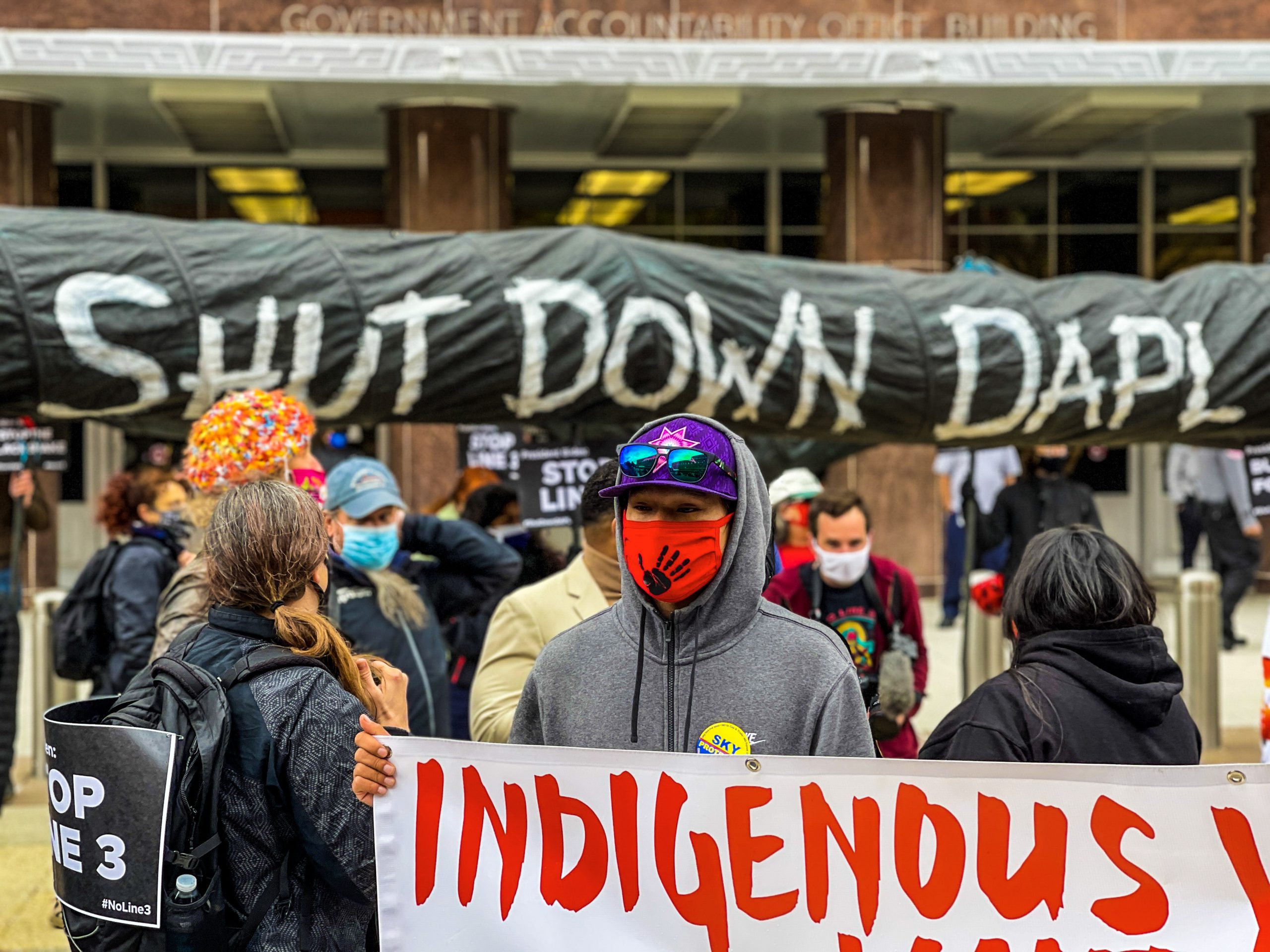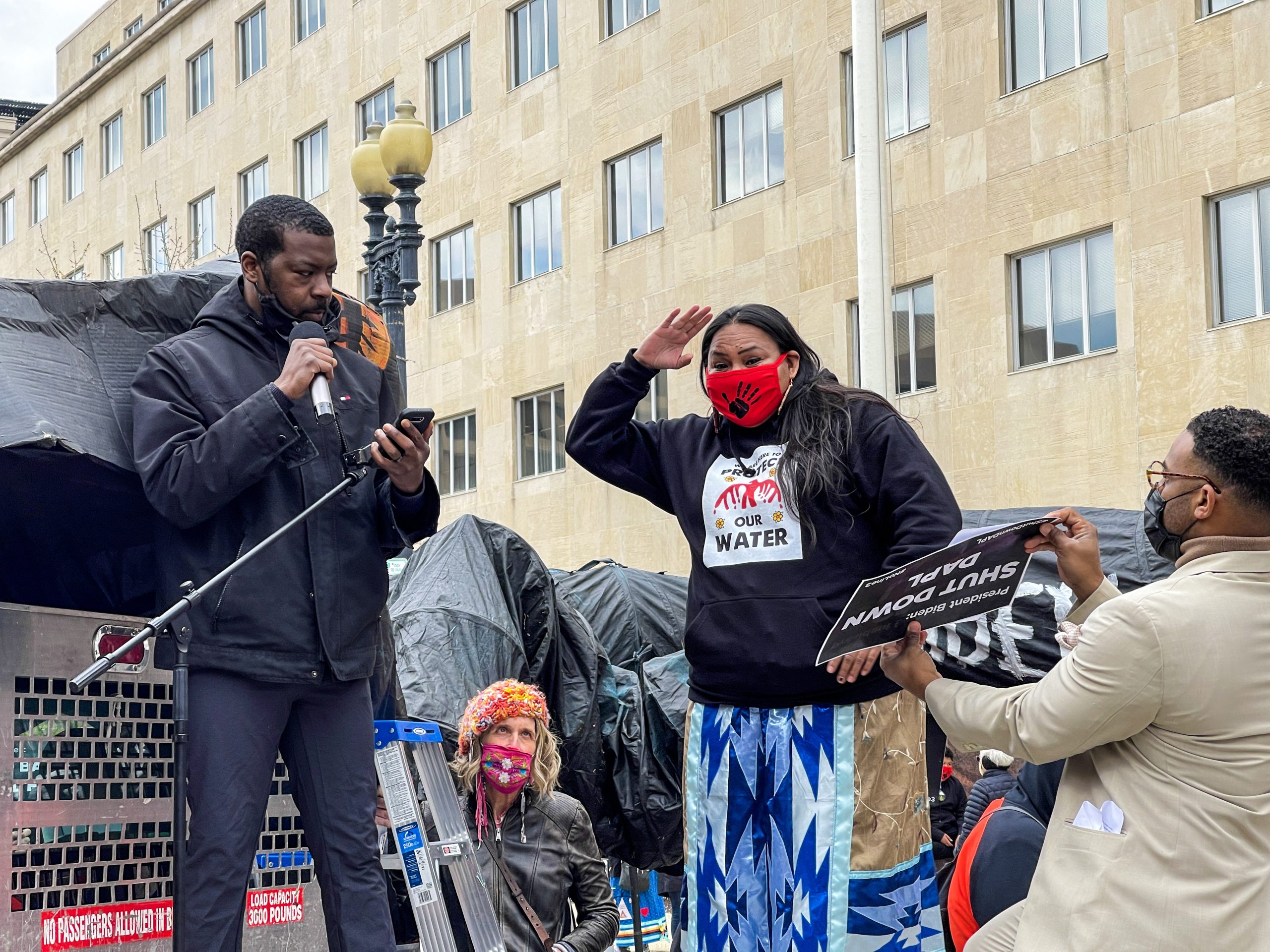
Starting with a run from the National Museum of the American Indian on Thursday morning, the youth called on President Biden to honor the 1868 Treaty of Fort Laramie and obtain the consent of their people when it comes to Dakota Access. The courts have already ruled that the federal government failed to consider how tribes of the Sioux Nation are impacted by the crude oil pipeline. “We are here to tell the Biden administration we do not want the Dakota Access Pipeline flowing under our rivers,” said Danny Grassrope, a Lower Brule citizen from the Cheyenne River Grassroots Collective of young Lakota organizers and activists. The U.S. Army Corps of Engineers approved the final portion of the pipeline in February 2017, during the administration of former Republican president Donald Trump. The decision was made without consulting tribes that had already sued the federal agency during the last year of Democratic former president Barack Obama’s second term in office.Lakota youth from Standing Rock Sioux Tribe and Cheyenne River Sioux Tribe running down National Mall. #ShutDownDAPL #StopLine3 @SRYouthCouncil #NoDAPL #LandBack pic.twitter.com/1jo8m9hlI9
— indianz.com (@indianz) April 1, 2021
Despite the court victories, the arrival of another U.S. president hasn’t resulted in the closure of the pipeline, whose final portion lies on territory promised to the Sioux Nation under the 1868 treaty. Youth expressed continued frustration with the state of affairs, prompting their return to Washington, D.C., where they marched from the headquarters of the Army Corps to the White House, carrying a physical manifestation of their opponent through the streets of the city. “The black snake symbolizes the Dakota Access Pipeline and we just now slayed it,” Maya Runnels, the president of the Standing Rock Youth Council, said at Black Lives Matter Plaza, which is about the closest the public can get to the White House due to increased security around the facility. “And now we’re giving it back to the White House, because we don’t want it on our land,” said Runnels after Lakota youth counted coup by striking down the 200-foot-long black snake at President Biden’s front door. About three dozen youth from Standing Rock, Cheyenne River and Lower Brule — some as young as 16 years old — left their homes in North Dakota and South Dakota last Saturday in preparation for their events in D.C. They were accompanied by parents, chaperones and family members. Along the way, the Lakota youth were hosted by the Meskwaki Nation in Iowa, where the Dakota Access Pipeline also runs through. Sarah Young Bear-Brown, a mother and activist from that tribal community, took part in the protest in D.C., speaking in front of the Army Corps headquarters in American Sign Language. “The pipelines always break. We need to stop these pipelines,” Young Bear-Brown signed. She later led the crowd in a vocalized chant of “Kill the black snake” against Dakota Access. Another group of Native activists also joined the events to call attention to the Stop Line 3 movement. The proposed oil pipeline would run through Ojibwe territory in northern Minnesota, where Silas Neeland, a 12-year-old citizen of the White Earth Nation, said it would cause major damage to wild rice, one of his people’s most important foods. “We are not here to ask Biden, but we are here to demand Biden because he needs to learn to respect our treaties and our water,” Neeland said at the Army Corps building.“We are here today to kill this big black snake”: Lakota youth from Standing Rock Sioux Tribe and Cheyenne River Sioux Tribe at US Army Corps of Engineers headquarters in #DC to tell President Joe Biden to #ShutDownDAPL. #StopLine3 @SRYouthCouncil #NoDAPL #LandBack @joebiden pic.twitter.com/kb0xS2ZQZk
— indianz.com (@indianz) April 1, 2021

The White House has not responded to media inquiries about Biden’s stance on Dakota Access. In contrast, he rescinded approval for the Keystone XL Pipeline on his first day in office on January 20. Tribes also fought heavily against the project. The events in D.C. took place on the fifth anniversary of the establishment of the Sacred Stone Camp, which was the first to arise in opposition to the Dakota Access Pipeline on April 1, 2016. The movement quickly expanded, attracting multiple camps and drawing upwards of 10,000 people during peak times of resistance, particularly in the summer of 2016 and then again in December of that year. In August 2016, shortly after the Standing Rock Sioux Tribe and the Cheyenne River Sioux Tribe began litigating the pipeline, Lakota youth completed a 2,000-mile relay run to the nation’s capital. The ReZpect Our Water event culminated with a rally in front of the White House. A number of the participants in the run were present on Thursday.Lakota youth from Standing Rock Sioux Tribe and Cheyenne River Sioux Tribe are at US Army Corps of Engineers headquarters in #DC to tell President Joe Biden to #ShutDownDAPL. #StopLine3 @SRYouthCouncil #NoDAPL #LandBack @joebiden @POTUS @WhiteHouse pic.twitter.com/rzIqBubaFb
— indianz.com (@indianz) April 1, 2021
A month after the Trump administration approved the final portion at Standing Rock, about 5,000 Native people and allies marched to the White House as part of Native Nations Rise on March 10, 2017. Thursday’s event was much smaller, with the crowd mindful of the ongoing COVID-19 pandemic. All participants wore masks and other protective equipment, starting with the run on the National Mall, and ending with the rally at Black Lives Matter Plaza.Marching from US Army Corps of Engineers to Black Lives Matter Plaza and White House tell President Joe Biden to #ShutDownDAPL. #StopLine3 @SRYouthCouncil #NoDAPL #LandBack @potus @whitehouse @JoeBiden pic.twitter.com/qS1TwRxFus
— indianz.com (@indianz) April 1, 2021
Cronkite News: Deb Haaland shares her vision for Interior Department (March 1, 2021)
Recap: #DebForInterior confirmation hearing (February 24, 2021)
Indigenously: Deb Haaland set for historic confirmation hearing (February 22, 2021)
Native women win major award for ‘Water Protectors’ book (January 27, 2021)
Standing Rock Sioux Tribe v. U.S. Army Corps of Engineers (January 26, 2021)
D.C. Circuit Court of Appeals: Standing Rock Sioux Tribe v. U.S. Army Corps of Engineers (January 26, 2021)
Native Sun News Today: Native activists hold Joe Biden to campaign promises (December 7, 2020)
Indian Country Today: The power of the Native vote (October 30, 2020)
Native Sun News Today: Tribes get more time to contest Dakota Access Pipeline (October 28, 2020)
Rodney Bordeaux: Joe Biden and Kamala Harris for Indian Country (October 22, 2020)
Press Release: Sen. Gallego (D-Arizona) protests firings at Department of Veterans Affairs
Native America Calling: The righteous rebellion of Indigenous punk rock
NAFOA: 5 Things You Need to Know this Week (March 31, 2025)
Chuck Hoskin: Cherokee Nation celebrates Cherokee women
Native America Calling: Tribal rights, a new restaurant and more are on The Menu
Native America Calling: Tribes vie for better access to traditional plants
Senate committee schedules confirmation hearing for Interior nominee
Fact Sheet: Department of Health and Human Services to undergo ‘dramatic restructuring’
Press Release: Department of Health and Human Services to undergo ‘dramatic restructuring’
Native America Calling: The new Social Security reality for Native elders
Montana Free Press: Hip-hop artist Foreshadow celebrates latest release
Cronkite News: Bill creates alert system for missing and murdered relatives
Bureau of Indian Affairs approves HEARTH Act regulations for Mohegan Tribe
House Subcommittee on Indian and Insular Affairs sets field hearing for self-determination anniversary
More Headlines